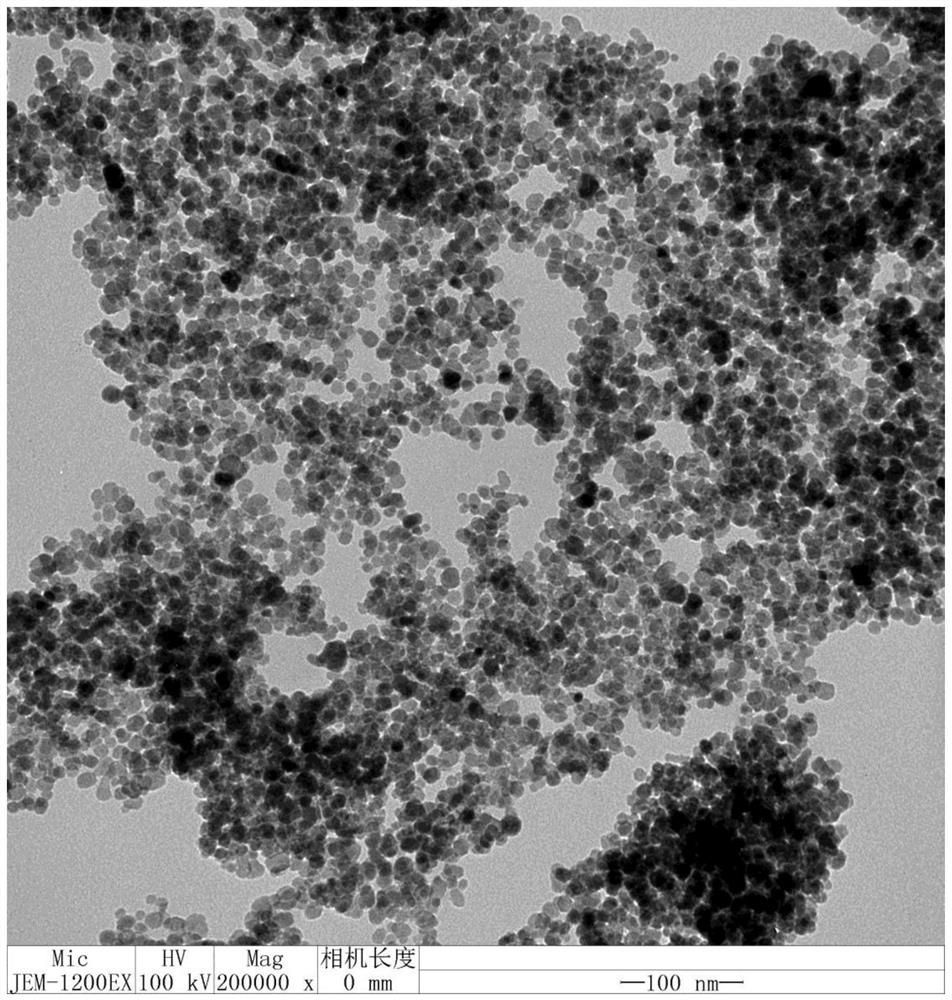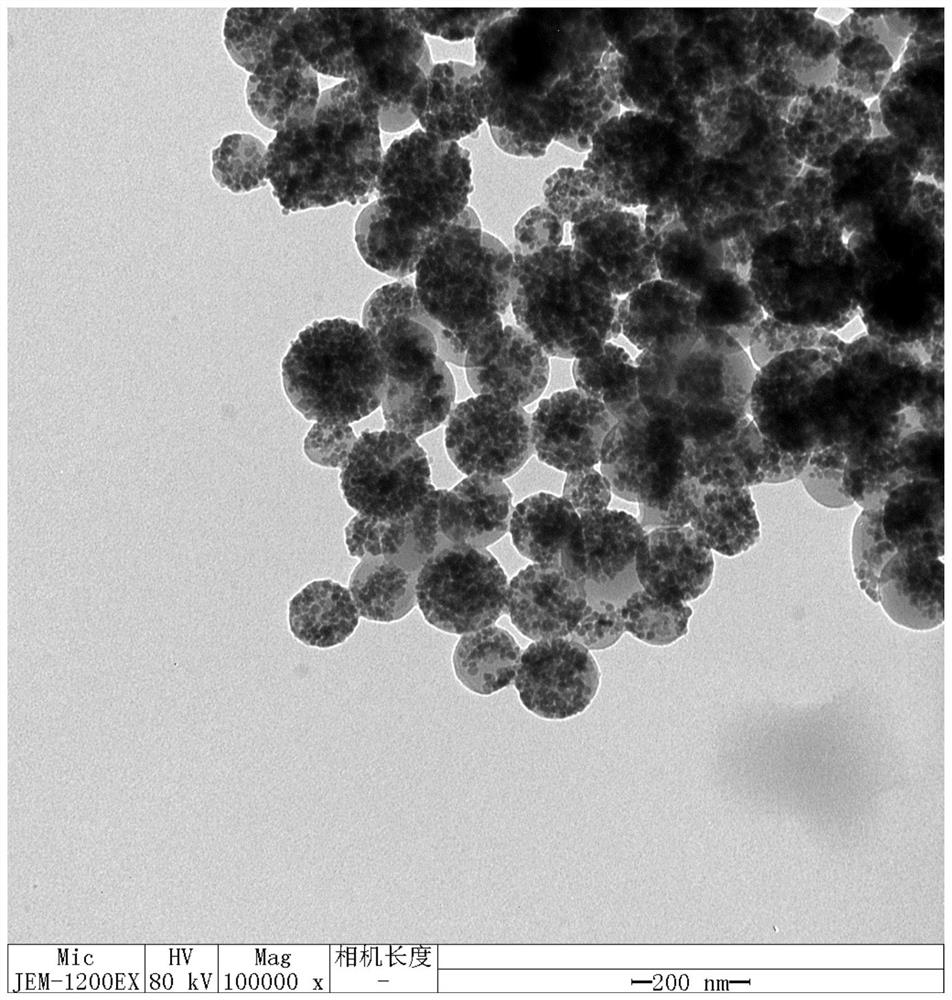A kind of magnetic nano particle and its application for preparing magnetic solid phase carrier
A technology of magnetic nanoparticles and solid-phase carriers, which is applied in the preparation method of peptides, the manufacture of inductors/transformers/magnets, peptides, etc., and can solve the problems of low chemical stability, easy aggregation of magnetic particles, and susceptibility to oxidation.
- Summary
- Abstract
- Description
- Claims
- Application Information
AI Technical Summary
Problems solved by technology
Method used
Image
Examples
Embodiment 1
[0035] The synthetic method of magnetic nanoparticle described in the present embodiment, comprises the following steps:
[0036] (1) 12g FeCl 3 ·6H 2 O and 4.9 g FeCl 2 4H 2 O was dissolved in 50mL deionized water, and then at 80°C under N 2In the atmosphere, quickly add 50ml of ammonia water to the above solution under vigorous stirring, and mix well;
[0037] After stirring for 30 minutes, 2 g of oleic acid was added to the above mixture, and the suspension was kept at 80° C. for 1 hour. After the reaction, the magnetic nanoparticles were washed with deionized water until neutral, and vacuum-dried to obtain oleic acid-modified Superparamagnetic Fe 3 o 4 particle;
[0038] The obtained oleic acid-modified superparamagnetic Fe 3 o 4 Particles were subjected to microscopic morphology analysis, and the results were as follows: figure 1 As can be seen from the figure, the superparamagnetic Fe modified by oleic acid 3 o 4 The particles have good monodispersity, unifor...
Embodiment 2
[0044] The synthetic method of magnetic nanoparticle described in the present embodiment, comprises the following steps:
[0045] (1) 12g FeCl 3 ·6H 2 O and 4.9 g FeCl 2 4H 2 O was dissolved in 50mL of deionized water, then at 70°C under N 2 In the atmosphere, quickly add 50mL ammonia water to the above solution under vigorous stirring, and mix well;
[0046] After stirring for 20 minutes, 2 g of oleic acid was added to the above mixture, and the suspension was kept at 70°C for 2 hours. After the reaction, the magnetic nanoparticles were washed with deionized water until neutral, and vacuum-dried to obtain oleic acid-modified Superparamagnetic Fe 3 o 4 particle;
[0047] (2) the obtained oleic acid modified superparamagnetic Fe 3 o 4 The particles are dispersed into n-hexane to form a magnetic fluid (the solid-to-liquid ratio of the magnetic fluid and solvent is controlled to be 0.125g / mL), and styrene, 4-(4-vinylbenzyl oxybenzyl alcohol) and divinylbenzene (DVB) (mo...
Embodiment 3
[0051] The synthetic method of magnetic nanoparticle described in the present embodiment, comprises the following steps:
[0052] (1) 12g FeCl 3 ·6H 2 O and 4.9 g FeCl 2 4H 2 O was dissolved in 50mL deionized water, and then at 80°C under N 2 In the atmosphere, quickly add 50mL ammonia water to the above solution under vigorous stirring, and mix well;
[0053] After stirring for 30 minutes, 2 g of oleic acid was added to the above mixture, and the suspension was kept at 80° C. for 2 hours. After the reaction, the magnetic nanoparticles were washed with deionized water until neutral, and vacuum-dried to obtain oleic acid-modified Superparamagnetic Fe 3 o 4 particle;
[0054] (2) the obtained oleic acid modified superparamagnetic Fe 3 o 4 The particles are dispersed into n-hexane to form a magnetic fluid (the solid-to-liquid ratio of the magnetic fluid and solvent is controlled to be 0.125g / mL), and styrene, 4-(4-vinylbenzyl Oxybenzyl alcohol) and divinylbenzene (DVB) ...
PUM
| Property | Measurement | Unit |
|---|---|---|
| particle diameter | aaaaa | aaaaa |
| particle diameter | aaaaa | aaaaa |
Abstract
Description
Claims
Application Information
 Login to View More
Login to View More - R&D
- Intellectual Property
- Life Sciences
- Materials
- Tech Scout
- Unparalleled Data Quality
- Higher Quality Content
- 60% Fewer Hallucinations
Browse by: Latest US Patents, China's latest patents, Technical Efficacy Thesaurus, Application Domain, Technology Topic, Popular Technical Reports.
© 2025 PatSnap. All rights reserved.Legal|Privacy policy|Modern Slavery Act Transparency Statement|Sitemap|About US| Contact US: help@patsnap.com



